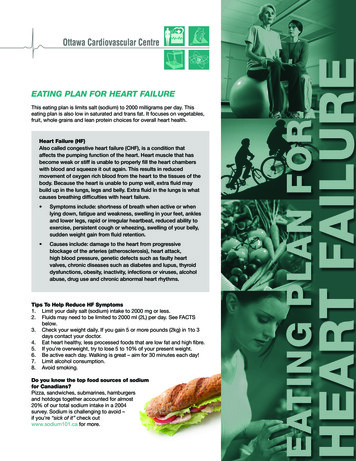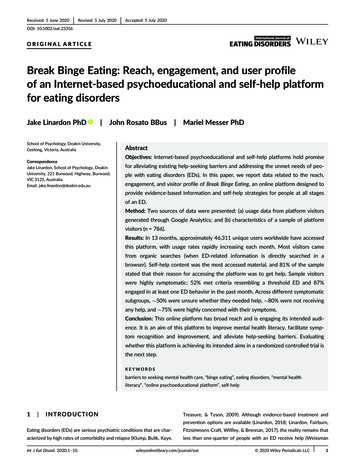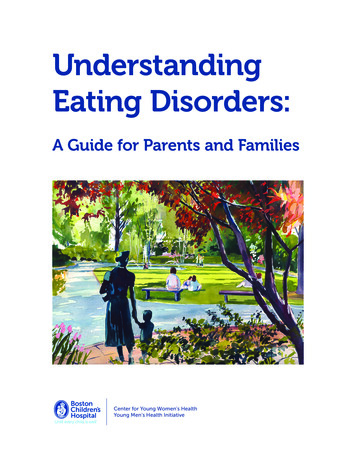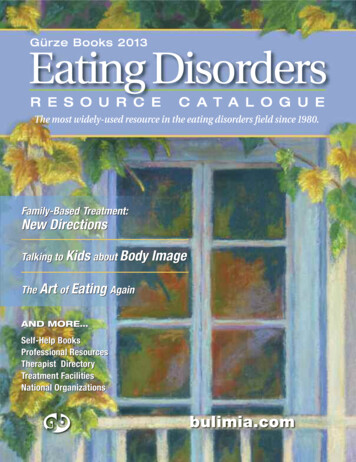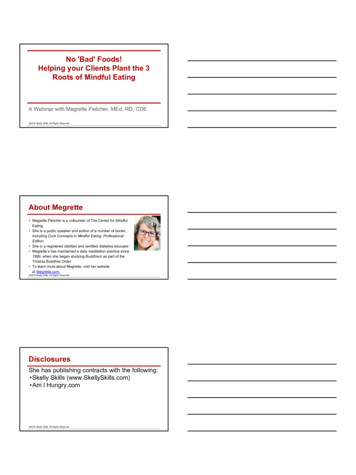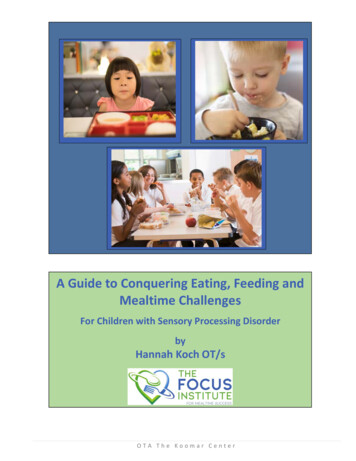
Transcription
A Guide to Conquering Eating, Feeding andMealtime ChallengesFor Children with Sensory Processing DisorderbyHannah Koch OT/sOTA The Koomar Center
About A. Jean Ayres, PhD, OTR, FAOTA, Founder of SensoryIntegration TheoryA. Jean Ayres, occupational therapist, developed the sensory integration frame of reference. Dr.Ayres was born in 1920 in Visalia, California. Growing up she struggled with everyday sensationsthat interrupted and impacted her ability to learn like her peers. Due to her difficult childhood,Ayres was determined to study the reasons why children like her had such difficulty with everydaytasks. She obtained a master’s degree in occupational therapy and a doctorate in educationalpsychology from the University of Southern California. Dr. Ayres later completed postdoctoralwork at UCLA’s Brain Research Institute where she began to develop her theory of sensoryintegration. Through her work, Dr. Ayres found children with sensory integration dysfunction hada neural disorder that affected their ability to interpret and process sensory information, such astouch and movement. From this discovery, she developed assessment tools such as the SouthernCalifornia Sensory Integration Tests (SCSIT) and later the Sensory Integration and Praxis Tests(SIPT) that helped occupational therapists identify this disorder in children. She created equipmentand treatment techniques, which now serve as the foundation to sensory integration intervention.This novel intervention approach changed the way occupational therapists treat children withsensory and motor challenges. Dr. Ayres believed therapy should emphasize the power ofsensations, be child-directed and be play-based to make the neural changes necessary to improvethe child’s ability to function in everyday life. Throughout the past decades, Ayres’ work has beenthe foundation for increased understanding of the relationship of sensory processing, motordevelopment and behavior in children. Her theory and terminology are used by many professionsthough they remain rooted in occupational therapy.Photo A Jean Ayres Jane Koomar. Used with permission.A GUIDE TO CONQUERING EATING, FEEDING AND MEALTIME CHALLENGES FOR CHILDREN WITH SENSORYPROCESSING DISORDER 2018 OTA The Koomar Center. All Rights Reserved. No part of this publication may be reproducedtransmittedin any formmeans, electronicincludingAllorimagesand photographsusedorinbythisanypublicationare royalty orfreemechanical,artwork obtainedfromphotocopying,Storyblocks.recording or any information storage and retrieval system, without permission in writing from thecopyrightownerat StatesThe FOCUSInstitute and OTA-The Koomar Center.Printedin theUnitedof AmericaPUBLISHED BY: The FOCUS Institute and OTA the Koomar Center,74 Bridge St. Newton, MA 02458 (617) 969-4410 www.otathekoomercenter.com2 OTA The Koomar Center
Table of ContentsHow Eating, Feeding and Mealtime Relate to Sensory Integration .4Occupational Therapy’s Role in Eating, Feeding and Mealtime Success .5Patterns of Eating, Feeding and Mealtime Challenges . .6Tips and Tricks to Support Mealtime at Home . 8How Occupational Therapy Promotes Mealtime Success . 10The FOCUS Program for Mealtime Success. . . . 11Oral Motor, Feeding and Mealtime Intervention . . . 12How Do I Know if my Child Would Benefit from Oral Motor Intervention?(Checklist) . . . 14Resources and References. . 153 OTA The Koomar Center
Sight Smell Taste Hear Touch Vestibular ProprioceptionHow Eating and Feeding and Mealtime Relate to Sensory IntegrationWe all have 7 senses that we use in our everyday lives:We use our sense of SIGHT to look at our plate of food, our utensils, and who is sitting with us.We use our sense of SMELL to smell the flavors of our food.We use our sense of TASTE to decide if our food is salty, sweet, sour or bitter.We use our sense of HEARING to listen to a meal cooking and others talking around the table.We use our sense of TOUCH to feel if our food is hot or cold, crunchy or soft.Our VESTIBULAR sense is the sense of moving, and maintaining an upright position.We use our VESTIBULAR sense to know which way is up or down, or how fast or slow wemove. The vestibular system has the greatest impact on daily function. It affects posture,balance, movement, coordination, attention and arousal. These things all help a child stay inhis seat at the table and remain engaged throughout meals.Our PROPRIOCEPTIVE sense is the sense of muscles working in our bodies and understanding thepositioning of our muscles in comparison to our own body and other objects.We use our PROPRIOCEPTIVE sense to know where our bodies are in space and how togenerate coordinated movements to successfully execute tasks. Movements which supportour proprioception sense include: climbing, crashing, bouncing, crawling and other heavymuscle work activities. We can see our proprioceptive sense when bringing food to ourmouth, and knowing how much food is in the mouth.Without conscious thought, we integrate each of these sensations in our bodies all the time.Sometimes children have trouble successfully integrating information from their sensations intotheir daily lives.4 Some have difficulties MODULATING sensory input, meaning they may be oversensitive,defensive or unable to filter out sensations. Children who have difficulty modulating inputmay have food sensitivities or be picky eaters. Modulation directly effects one’s arousal,attention and behavioral responses. A high level of arousal can lead to mealtime problems. Others have trouble DISCRIMINATING sensory inputs, meaning they may have difficultyperceiving specific qualities of sensations. This results in a child who has decreased awarenesssensory inputs. Discrimination directly affects one’s skill building, such as knowing where foodis in the mouth or how to drink from a cup without spilling. The ability to plan and sequence the steps of these motor tasks, called PRAXIS, is dependenton effective sensory discrimination. Children with praxis problems may have difficultycoordinating how to scoop food, bring food to the mouth, move food in the mouth, or holdutensils.OTA The Koomar Center
Occupational Therapy’s Role in Eating, Feeding and Mealtime SuccessOccupational Therapy practitioners (OTs) recognize how essentialbeing able to eat and feed one’s self is as a daily living skill. It is acrucial a developmental milestone for children as well as a skill thathas medical, social and emotional implications for children and theirfamilies.Mealtime challenges often result in far reaching negative effects forthe child, their family and others in their life. It may be difficult for achild to engage in food-related activities in meaningful settings, suchas birthday parties and eating out at a restaurant.What is the difference between “feeding” and “eating”? Occupational Therapists define feeding as “setting up, arranging, and bringing food [orfluid] from the plate or cup to the mouth”. This includes manipulating utensils,management of food on the plate (cutting and scooping), and things like pouring juice orsyrup. These skills require developed praxis and motor coordination.Eating refers to “keeping and manipulating food or fluid in the mouth and swallowing it(swallowing is moving food from the mouth to the stomach)” (AOTA, 2014). Oral motorskills and sensory sensitivities can impact eating.Children may have difficulty with one or both of these skills.What is the relationship between eating, feeding or mealtimechallenges and sensory processing? Eating is one of the only tasks that a child does that requires the use of all seven senses.Integrating all of this information is complex! Sensory modulation challenges result in over-sensitivities or defensiveness. If a child issensitive to tastes and textures, he may have limit food intake resulting in a restricteddiet with limited nutrition. He may be sensitive to having food in and around the mouth,or be over-responsive to food smells and sounds, such as people eating. Sensorymodulation challenges may lead to an increased arousal level, which can impact a child’sability to maintain their focus and behavior during mealtime. Decreased sensory discrimination can result in decreased awareness of food in andaround the mouth. This may make it difficult for a child to be aware of where food is intheir mouth which can limit their food preferences. It may also impact oral motor abilityto use the tongue and lips effectively for eating. Postural control and praxis (motor)problems may result in difficulties sitting at a table, managing utensils or cutting up orscooping food.5 OTA The Koomar Center
Patterns of Eating, Feeding and Mealtime ChallengesOccupational Therapists define six individualized eating, feeding andmealtime profiles based on a child’s sensory difficulties.Some children have challenges with multiple areas of sensory and motor functioning that impacteating and mealtime performance. This pattern is called a Generalized Sensory and MotorDysfunction. Characteristics of this pattern are: Challenges stem from a combination of modulation, discrimination, postural and praxis difficultiesChild may have extreme discomfort around sensory properties of food, difficulty maintainingposition in chair, difficulty with chewing and utensil useLikely have challenges outside of mealtime as well, such as paying attention at school andprocessing sensory information in the community. Some children only have problems with discrimination of sensory inputs thatmay affect their postural control, motor skills and or oral motor skills. This ispattern is called Generalized Sensory Discrimination Dysfunction andcharacteristics of this pattern are: Difficulty assuming and maintaining body position in chairDifficulty using and manipulating utensilsLimited chewing patterns restricting food repertoireDifficulty with completion of activities of daily living such as dressing andbathing; engagement in social activities and sports; and negotiation oftheir everyday settings in a safe mannerSome children demonstrate over sensitivities to multiple types of sensory stimuli. This pattern iscalled Generalized Sensory Defensiveness and characteristics are: 6 Extreme discomfort with everyday sensory experiences such as focusing in a busy environmentand not wanting to be touchedNegative responses such as fear or discomfort with smell, taste or texture of foods.Difficulty with attention, rigidity around foods, and strong behavioral responses such asoutbursts at the tableOTA The Koomar Center
Some children demonstrate sensory sensitivities that may impact a child’s oral motor structures (lips,cheeks, tongue) but may not impact the rest of the body. This pattern is called Oral SensoryDefensiveness and characteristics are: Extreme discomfort with the taste, texture and smell of foods resulting in avoidance of theseexperiencesSelectivity of food based on their defensiveness (i.e. needing food to be the same brand, preparedthe same way)Strong protective reactions to exposure to certain foods or smells (i.e. gagging, throwing up).Some children demonstrate sensory discrimination problems that mayimpact a child’s oral motor structures but not the rest of the body. Thispattern is called Oral Sensory Discrimination Based Oral MotorDifficulties and characteristics are: Delayed oral motor skillsOften messy eaters; exhibit immature chewing patterns; selectfood based on oral motor demandsSensitivity to tastes and smells are also possible, which cancontribute to a child’s eating preferencesMay be grazers, eating small amounts of food many timesthroughout the day, often due to fatigue from chewingSome children have difficulty with both oral defensiveness and sensory discrimination in oral structures.This pattern is called Combined Oral Sensory Defensiveness/ Sensory Discrimination Based Oral MotorDifficulties and characteristics are: 7 Combination of the two patterns listed aboveAs babies, these children do not like the feeling of objects in their mouth. This leads to a lack ofexploration of the world through the mouth, which is typical for a baby’s development. This lackof exploration leads children to later have a hard time understanding the qualities of foods(smooth, crunchy, or mixed texture).Children may exhibit extreme discomfort (sensory defensiveness) around the sensory propertiesof food as well as the related oral motor control problemsOTA The Koomar Center
Tips & Tricks to Support Mealtime Success at HomeGeneral Sensory TipsEvery child’s sensory systems are different and have differing thresholds. In general, it is beneficialfor a child to have opportunities to engage with their sensory environment in an emotionally safemanner. Here are some general strategies to address overall sensory function, which can be doneoutside of mealtime. 8 Provide exciting environments with many things to look at and new sounds to hear.Allow them to play on various tactile surfaces, like grass and sand.For a child who is overly sensitive to any sensory stimuli, try to “turn down the volume” of thatsensation. For example, if a child is very distracted by visual information, give them a cozy spacein your house (such as a tent or fort) that blocks out overwhelming visual inputs.If a child is bothered by sound, allow them to try noise cancelling headphones in a busyenvironment.Engaging in activities that decrease sensitivity can also be beneficial, if the child is ready. Forexample, if your child is sensitive to getting their hands messy, providing opportunity for playwith a variety of tactile media like sand, shaving cream or dry beans can increase their toleranceover time.For a child with decreased awareness of sensory stimuli in their environment, try to “turn upthe volume” of that sensation.Provide your child with a variety of movement opportunities (jumping, sliding, running,crawling) for the development of their postural muscles. Postural control is necessary for sittingat the table.OTA The Koomar Center
Mealtime TipsStrategies for Smoother Mealtimes 9 Getting into a predictable mealtime routine with children helps them know what to expect.Do not force a child to eat anything. Creating positive interactions with food and pleasantexperiences at the table are important in helping a child feel safe. Feeling safe is essential fora child to take risks, such as trying something new.Allow children to play with their food and get messy! Children can learn about new foods usingall of their senses. If playing with food at the dinner table is becoming a problem, set up a “foodplay time,” for food exploration.It is helpful for parents to use rich, descriptive language when a child is exploring new foods,rather than just labeling them as “yummy” or “yucky”. Describing sensory qualities to the child(crunchy, smooth, wet, cold, sweet etc.) helps a child know what to expect, before they evenget to the tasting part!If a child shows interest in helping preparing a meal or snack, get them involved with shoppingfor and preparing food.Limit distractions as much as possible while eating. Turning off the TV, changing a child’s chairposition so it faces less visual distractions, and removing toys from the table helps the childfocus on the goal of eating.OTA The Koomar Center
How Occupational Therapy Promotes Mealtime SuccessOccupational therapy addresses difficulties in the following areasSensory Processing Skills Therapy provides rich, whole-body sensory experiences that can decrease tactile defensiveness over time,increasing tolerance for a variety of food textures. Oral tactile discrimination improves through sensory stimulation, using a variety of oral toys and activities.This leads to an increased ability to manipulate and clear food in the mouth.Oral Motor Skills Using a variety of therapeutic oral games and activities, a child’s jaw can become stronger in order to bite andchew a variety of food textures. Occupational therapy may target increased lip closure on cups and spoons with mouth games and toys forthe mouth. Addresses tongue control, which is necessary for manipulating food within the mouth. Once oral foundations are addressed, focuses on promoting eating and drinking skills.Posture, Praxis and Motor Skill Provides whole-body movements such as crawling and climbing improve postural stability, helping a child sitat a table during a meal. Children may work on motor planning skills in therapy to cut, spear and scoop food with utensils.There are many eating and feeding programs established to help children who are picky eaters. Some programs arestand alone and may be used by other disciplines than occupational therapy. Some OT’s integrate strategies fromseveral of these programs into their treatment approach. You may wish to explore which program or combination isbest for your child. Some examples of common programs follow. 10 The SOS Approach (Sequential Oral Sensory): Assesses and addresses feeding issuesBeckman Oral Motor Protocol: Addresses oral motor skillsMealtime Notions with Marsha Dunn Klein: Targeting mealtime challengesApplied Behavior Analysis (ABA): Aims to change a child’s behavior through identifying antecedent,behaviors and consequences.FOCUS Program: Unlike other programs, the FOCUS approach addresses foundational sensory processingand motor skills. Therapists using the FOCUS approach may draw on knowledge and strategies from otherprograms that they have training in while still following the phases of the FOCUS Program.OTA The Koomar Center
The FOCUS Program for Mealtime SuccessFamily-Centered, Oral Motor, Comprehensive, Underlying IssuesAddressed, SensorimotorThe FOCUS Program is a family-centered modeland intervention program for feeding and oralmotor challenges. It addresses an individual’ssensory processing and motor skills withfunctional oral motor and feeding skills, andmealtime behaviors and participation. FOCUS assessment and treatment is selected specifically to meet the individual needs ofeach child and family.The FOCUS intervention program is a phase-based approach consisting of 6 stages. Thephases progress from whole body awareness to the ability to eat in diverse functionalenvironments.It is appropriate for individuals with a variety of diagnoses to improve eating andmealtime participation, including Sensory Processing Disorder (SPD), Autism SpectrumDisorder (ASD), Avoidant Restrictive Food Intake Disorder (ARFID), children who wereborn prematurely, tube fed individuals, and individuals with Trauma and AttachmentDisorders.What will a FOCUS assessment look like?Areas evaluated in a typical assessment are: Whole body sensory and motor processing: In a large gym space, the OT will observehow the child processes different types of sensory input and how they interact with theirenvironment. They may use a combination of formal and informal assessment tools. Oral motor structures and feeding: (tongue, lips, and cheeks) and functions (swallowing,chewing, clearing of the mouth). The OT may ask parents to bring snacks from home thatthe child is familiar with, including something crunchy, smooth, chewy and a food thatthe child used to eat but doesn’t anymore. Information will also be gathered aboutpreferred foods to inform the therapist about a child’s sensory processing oral motorskills Mealtime behaviors: The OT will make observations and gather information fromparents about mealtime behaviors and the impact of the child’s overall mealtimepatterns the family.11 OTA The Koomar Center
Oral Motor, Feeding and Mealtime InterventionIntervention approaches for oral motor and mealtime problems vary by profession and philosophicalapproach. Occupational therapy intervention for these problems that utilizes a sensory integrationbased approach (such as that used in the FOCUS program) should typically include the followingcomponents and approaches.General Guidelines Based on a comprehensive assessment, the Occupational Therapist should identify whichpattern or oral motor/mealtime dysfunction applies to the child and use a clinical reasoningapproach to determine where to begin and how to progress intervention.The intervention should emphasize the child’s comfort and feelings of safety and security.Family support and education, along with interdisciplinary collaboration, should occurthroughout the process.Depending on the child’s needs, foundational skills such as sensory modulation,discrimination, posture and respiration should be addressed before progressing to directinterventions involving oral motor skill development or food interactions.A variety of activities and techniques may be used throughout the intervention process.This model from the FOCUS program illustrates the recommended progression of interventionactivitiesFamily SupportInter-DisciplinaryCollaborationPhase 4Phase 1Whole BodyPhase 2Phase 3Oral SensoryOral Motor SkillFoodExploration(non oral)12 OTA The Koomar CenterEducation & ToolsPhase 5FoodExploration(oral) &consumptionPhase 6Eating inFunctionalEnvironments
Progression of InterventionIntervention for oral motor, eating and mealtime problems develops through a natural progressionof phases as illustrated in the preceding figure. Best-practice intervention for these problems willuse assessment information and solid clinical reasoning to inform the clinician as to which phase ofintervention the child should begin. Children may spend varying amounts of time in each phase. Abrief description of the areas of function addressed in each of the phases follows.Phase 1: Whole BodyThe purpose of this phase is to address whole body sensory and motor needs. Intervention is basedon traditional sensory integration treatment strategies which involve whole body activities. Childrenin this phase may spend most, if not all, of their treatment session engaged in gross motor activity.Phase 2: Oral SensoryThe purpose of this phase is to decrease sensitivity of and/or improve sensory discrimination of oralstructures (lips, tongue, cheeks). Activities in this phase will involve specific oral motor games toaddress the specific sensory modulation or discrimination problem of the child.Phase 3: Oral Motor SkillThe purpose of this phase is to strengthen and promote increased control and use of oral structures(lips, tongue, cheeks). These skills facilitate the child’s ability to manipulate food in the mouth, bite,chew, and swallow food effectively.Phase 4: Food Exploration (Non Oral)The purpose of this phase is to increase tolerance smells, tastes and textures of a variety of food asa precursor to putting foods in the mouth and consuming them for nutrition. Activities will typicallyinvolve food-based play, games and activities that require touching, looking at and smelling novelfoods without bringing food to the mouthPhase 5: Food Exploration (Oral & Consumption)The purpose of this phase is to increase tolerance for a wider repertoire of foods for increasedconsumption. Activities will typically involve food-based play in which child places novel foods in themouth or eats food.Phase 6: Eating in Functional EnvironmentsThe purpose of this phase it to promote eating meals in the community (restaurants, school) and athome. Emphasis is on functional carryover and transfer of skills developed in previous phases.13 OTA The Koomar Center
How do I know if my child would benefit from oral motor intervention?Your child should be considered for oral motor assessment and possible intervention if 3 or more of thefollowing apply to their current eating and mealtime status.1. Limited repertoire of foods are eaten on a regular basis2. Inadequate nutrition and/or intake for growth3. Gagging and/or choking on foods4. Limited ability to chew or swallow foods5. Difficulty being near less familiar foods (i.e. food being prepared, on table)6. Difficulty eating foods of varying flavors, textures and smells7. Is highly specific about foods he or she will eat – for example, needing a food prepared a certainway or only accepting a certain brand of a food8. Difficulty using a straw, utensil and/or cup9. Resistive behaviors and/or tantrums related to eating10. Fatigues with eating (e.g., requires breaks, eats very small portions)11. The pace of eating is too fast or too slow12. Has sloppy eating habits13. Stuffs mouth with food14. Unable to sit at the table with the family during mealtime15. Difficulty eating in different environments or with different people (i.e. restaurants, school)16. You and/or your child experience heightened levels of stress around mealtime17. Your child exhibits challenges during mealtime that impact their enjoyment of mealtime18. Your child exhibits challenges during mealtime that impact the enjoyment of mealtime for otherfamily members14 OTA The Koomar Center
ResourcesBooks for ChildrenJust Take a Bite, Ernsberger, Lori; Stegen-Hanson, Tania (2004)How to Teach Nutrition to Kids, Liakos Evers, C. (1995), 24 Carrot PressOral-Motor Activities for School-Aged Children, Mackie, E. (1996), LinguiSystems, Inc.Mouth Madness Oral Motor Activities for Children, Orr, C. (1998), Therapy Skill Builders.Oral Motor apro.comReferencesAmerican Occupational Therapy Association. (2014). Occupational therapy practice framework: Domain andprocess (3rd ed.). American Journal of Occupational Therapy, 68(Suppl. 1), S1-S48.Benson, J. D., Parke, C. S., Gannon, C., & Muñoz, D. (2013). A retrospective analysis of the sequential oralsensory feeding approach in children with feeding difficulties. Journal of Occupational Therapy,Schools, & Early Intervention, 6(4), 289-300.Benjasuwantep, B., Chaithirayanon, S., & Eiamudomkan, M. (2013). Feeding problems in healthy youngchildren: prevalence, related factors and feeding practices. Pediatric reports, 5(2), 38.Fisher, M. M., Rosen, D. S., Ornstein, R. M., Mammel, K. A., Katzman, D. K., Rome, E. S. et al. (2014).Characteristics of avoidant/restrictive food intake disorder in children and adolescents: a "newdisorder" in DSM-5. J.Adolesc.Health, 55, 49-52.Phalen, J. A. (2013). Managing feeding problems and feeding disorders. Pediatr.Rev., 34, 549-557.Suarez, M. A. (2015). Multicomponent treatment for food selectivity in children: description and case report.Nutr.Clin.Pract., 30, 425-431.15 OTA The Koomar Center
Occupational Therapy's Role in Eating, Feeding and Mealtime Success . What is the difference between "feeding" and "eating"? Occupational Therapists define feeding as setting up, arranging, and bringing food [or " fluid] from the plate or cup to the mouthThis includes manipulating utensils, ".



